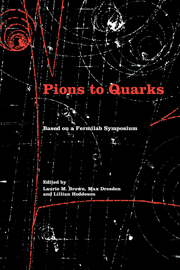Book contents
- Frontmatter
- Contents
- List of contributors
- Foreword by Leon M. Lederman
- Editors' acknowledgments
- Photographs of the symposium
- List of abbreviations
- List of notation
- I Introduction
- II Particle discoveries in cosmic rays
- III High-energy nuclear physics
- IV The new laboratory
- V The strange particles
- VI Weak interactions
- 24 Detection of the neutrino
- 25 Recollections on the establishment of the weak-interaction notion
- 26 Symmetry and conservation laws in particle physics in the fifties
- 27 A connection between the strong and weak interactions
- 28 The weak interactions from 1950 to 1960: a quantitative bibliometric study of the formation of a field
- VII Weak interactions and parity nonconservation
- VIII The particle physics community
- IX Theories of hadrons
- X Personal overviews
- Name index
- Subject index
26 - Symmetry and conservation laws in particle physics in the fifties
Published online by Cambridge University Press: 07 May 2010
- Frontmatter
- Contents
- List of contributors
- Foreword by Leon M. Lederman
- Editors' acknowledgments
- Photographs of the symposium
- List of abbreviations
- List of notation
- I Introduction
- II Particle discoveries in cosmic rays
- III High-energy nuclear physics
- IV The new laboratory
- V The strange particles
- VI Weak interactions
- 24 Detection of the neutrino
- 25 Recollections on the establishment of the weak-interaction notion
- 26 Symmetry and conservation laws in particle physics in the fifties
- 27 A connection between the strong and weak interactions
- 28 The weak interactions from 1950 to 1960: a quantitative bibliometric study of the formation of a field
- VII Weak interactions and parity nonconservation
- VIII The particle physics community
- IX Theories of hadrons
- X Personal overviews
- Name index
- Subject index
Summary
The “Gruppenpest” that so many physicists fought against before the war died out during the 1940s. Although some famous physicists made pioneering, fundamental contributions in the theory of infinite-dimensional representations of groups, the community of physicists ignored them.* However, in the late forties, with the discovery of new particles (π mesons and V particles), the need arose to know more about conservation laws. For instance, that a spin-1 boson cannot decay into two photons was known from a short, brilliant paper by Lev Landau and from Eugene P. Wigner's un-published findings, quoted by Jack Steinberger. Using field-theory concepts, particle physicists were eager to establish the list of selection rules for particle decays; for example, C. N. Yang and D. C. Peaslee gave their proof of spin 1 ↛ 2γ. In a long review I wrote in 1951, I carefully referenced all that was known. A complete list of selection rules for angular momentum and parity conservation appeared only later.
Then came the θ – τ puzzle. Its history is recounted excellently by Richard Dalitz in Chapter 30. Apparently this was a typical case of the parity doublet; T. D. Lee and Yang described it in an elegant paper, six months before they proposed parity violation as the explanation. So much has been written on the history of P violation (and some contributions to this conference are devoted to it) that I wish here only to mention some “prehistoric” relevant publications. Pierre Curie, in a fundamental and classic paper (in which he formulated his famous symmetry principles), explained parity conservation and the difference between axial and polar vectors in classical physics.
- Type
- Chapter
- Information
- Pions to QuarksParticle Physics in the 1950s, pp. 373 - 383Publisher: Cambridge University PressPrint publication year: 1989



